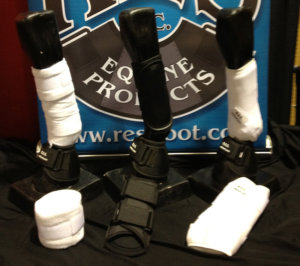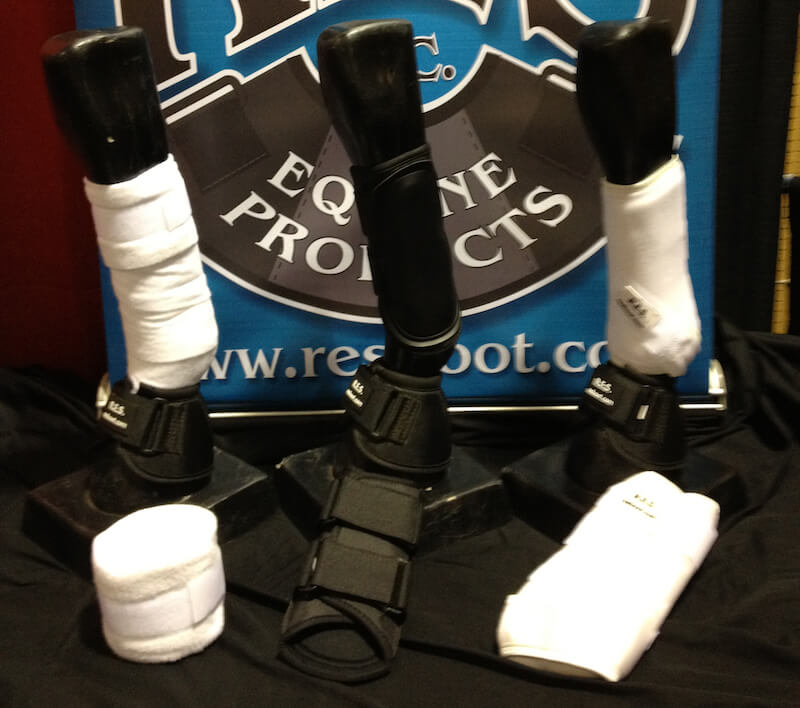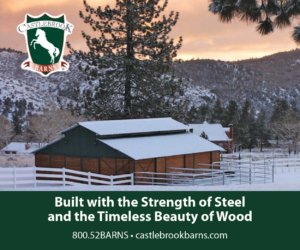How to Boot Up Your Horse for Safety and Support
by Allison Trimble, Willfully Guided Horsemanship

In very physical equine sports, like performance horse competition, leg protection is important. Injury to a horse’s legs can be career ending. There are a lot of types and brands of leg protection and sometimes it is hard to decide what is best for your horse. I asked Brett Mills, of RES Boots, to help outline the types of boots and their uses so you can make an informed decision.
Bell Boots: These protect the horse’s hoof and heel bulb from overreaching and coronet band from being unjured when turning. There are many types from pull on rubber boots, to quick wrap and no-turn boots. I personally use them every time I go down the fence, and with horses that are learning to turn around.
Splint Boots: These protect the horse’s cannon bone from side impact and brushing of the legs. The advantage to this style of boot is that they have excellent impact protection and are light weight and easy to use. The disadvantage is that they don’t offer any suspensory support. This is my boot of choice for everyday use. I am more concerned about impact damage than I am about suspensory support. I also like the way these fit with a bell boot.
Sport Boots, Tendon Boot, Suspensory Boots: This style of boot is fitted around the cannon bone with an additional support strap that wraps under the fetlock joint. They provide some suspensory support and more comprehensive fetlock protection than splint boots. They do not offer as much side impact protection, they hold in more heat on the leg and are harder to use. They can be hard to use with bell boots and rub on the horse’s pastern. There are some versions of a bell boot/ suspensory boot that are called a combination boot that avoid this problem.
Polo Wraps: The key to using polo wraps is wrapping them properly. They can be used on either the front or hind legs. They offer good protection and support, are inexpensive and easy to wash. They are very hard to use and somewhat time consuming, and it is important to note that if you are using them for competition that you tape the top of them so that there is no risk of them coming lose during the run.
Skid Boots, Hind Boots: These protect the fetlock from burning when the horse is stopping. There are two styles. A traditional leather or neoprene skid boot has straps that go above and below the fetlock and only protects from burning. Hind boots typically have a protective cup for the fetlock as well as a more full coverage protection from side impact for the cannon bone. For reining I usually use a leather skid boot, while for cowhorse, I like the added impact protection of a hind boot.
Ballistic nylon is the preferred material for the outer shell of bell boots over a neoprene inside. Another material used in making boots is Kevlar and PVC Material or rubber. Polo wraps are made from a cotton and polar fleece blend, while splint boots use ballistic nylon or UNLB. Sport boots commonly are made of UNLB over neoprene and RES Boots use blended wetsuit material to keep the boot soft.
Knowing how to properly use and adjust your leg protection is extremely important, regardless of the type used. You can sometimes do more damage to tendons by improper wrapping or tightening. It is also important to keep them clean and dry. If your horse is working hard and sweating a lot, you should be sure to take off the boots when you are done working and air out and cool down their legs. If I am just going out to lope a horse, I don’t use any boots, but if I am going to be getting physical on a horse, I always use full boots. Your horse’s performance is affected when they are hurt in a maneuver. The quickest way to get a horse to quit stopping hard is to really burn his fetlocks. There is no reason to take the risk of hurting a good horse when it is preventable.
Brett Mills is the owner of RES Boots based out of Redmond, OR. A common problem with all brands and boots is Velcro failure. RES boots has addressed this problem by designing and patenting a boot with replaceable Velcro. To learn more visit www.resboot.com
Published November 2012 Issue

Allison Trimble is a Realtor® specializing in equestrian properties, farm and ranch properties, and residential real estate. As a former horse trainer, and a current owner, breeder and non-pro competitor in cow horse and reining events, she combines her experience in the horse industry with her lifelong real estate expertise to guide her clients through the real estate process.
Learn more at www.coastalrealtywa.com





